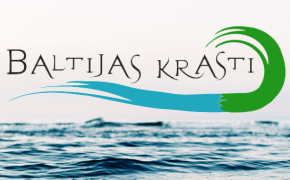The student sorority Selga volunteered for a citizen science study – microplastic pollution detection along the coastline of Latvia by washing and sieving sand.
Microplastic pollution is persistent, long lasting and increasing, and there is growing scientific evidence on its potential harm on both animals and human beings. To choose appropriate microplastics pollution management activities, it is important to establish a baseline information on actual pollution presence in the nature. Baltic Sea is one of the environmental treasures of Latvia and an important biotope supporting existing biodiversity. The sea has a coastline of almost 500 km in Latvia. Microplastic pollution has never been studied there. The objective of the practice was to map microplastic pollution along the whole coastline of Latvia for the first time, creating a starting point for new knowledge and possible future monitoring and contribution to a global understanding of microplastic pollution distribution and presence. In 2021, the student sorority Selga decided to volunteer for marine environment protection – citizen science study. This organization cooperated with LIAE to develop a simple study design for microplastic mapping along the coastline. The project was financed from donations provided by sorority members. During three summer months members of the sorority together with their families, friends, journalists, NGOs and other society members accompanied by LIAE assistants collected, washed and sieved sand from 25 sampling areas – beaches in Latvia. The main stakeholders are scientists, policy makers, municipality representatives, general society.
Resources needed
We used approx. 2000 EUR in order to purchase sampling kits, lab ware and cover travel expenses for scientific assistants accompanying sampling group. Around 10 scientific experts and 250 participants were involved for sampling activity. After sampling work is still in progress and covered by LIAE.
Evidence of success
This activity recieved a lot of media attention and attracted interest despite having no particular communication plan in action. Besides sorority members, unexpected volunteers, sometimes beach visitors on the spot applied to take part in the sampling. During summer there were around 20 different posts, news, interviews in newspapers, web portals, radio and television made. Volunteers from 8 different schools/sport clubs, 5 NGOs, 2 municipalities and 2 televisions participated in sampling.
Difficulties encountered
Even though sampling protocol was prepared and tested by scientific personnel, it was updated and improved several times during the sampling campaign based on feedback from volunteers. Protocol has to be flexible, as not everywhere sieving was possible due to weather and sand size.
Potential for learning or transfer
The project design is comparatively simple, equipment used can be adapted to be even cheaper, methods applied are easily understandable by fieldwork participants, including children. To make the process faster, just one size fraction sieving can be used (in this project we used 2 sieves in order to obtain 3 different size fractions samples) - 5 mm sieves to get first and visually evidenced proofs of pollution by sieving. This can be easily done by local schools, plastic particles above 5 mm can be detected by the naked eye, picked out and sent to scientists for polymer identification. Hence a large area is covered, new data obtained in rather short time period provides with the possibility to evaluate the pollution amount more precisely. Such simple activity can be done everywhere, where there is a sandy coastline of various water bodies present. By combining the data obtained, we can build a comprehensive database to have a global understanding of plastic pollution.
Tags: Citizen engagement, Education, Environment, Marine litter, Microplastics, Plastics, Pollution, Science, Volunteering, Waste








